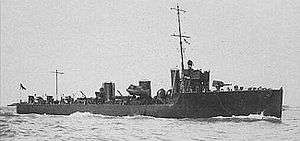HMS Lynx (1913)
 | |
| History | |
|---|---|
| Name: | HMS Lynx |
| Builder: | London and Glasgow Shipbuilding Company[1][2] |
| Yard number: | 364 [1] |
| Laid down: | 18 January 1912 |
| Launched: | 20 March 1913[1][2] |
| Completed: | January 1914[1][2] |
| Fate: | Sunk by a mine on 9 August 1915[1][2] |
| General characteristics | |
| Class & type: | Acasta-class destroyer |
| Displacement: |
|
| Length: | 267 ft 6 in (81.53 m) |
| Beam: | 27 ft (8.2 m) |
| Draught: | 10 ft 6 in (3.20 m) |
| Installed power: | 24,500 ihp (18,300 kW) |
| Propulsion: |
|
| Speed: | 29 kn (54 km/h) |
| Complement: | 72 |
| Armament: |
|
HMS Lynx was an Acasta-class destroyer of the Royal Navy. She was built on the River Clyde by London and Glasgow Shipbuilding Company.[1][2]
Lynx was built as yard number 364, and was 267 ft 6 in (81.53 m) in length, 27 ft (8.2 m) in breadth and had a draught of 10 ft 6 in (3.20 m). She was powered by a steam turbine engine which produced 25000 shp.[3] She was commanded from 16 December 1913 by Commander Reginald St Pierre Parry.[4]
Lynx was part of the response to the German bombardment of Scarborough on 16 December 1914. At 05:15 she sighted the German destroyer SMS V155, and summoned her destroyer squadron to investigate. The brief skirmish took place with a force of German destroyers and cruisers, and Lynx was hit several times by German shells. She sustained minor damage to a propeller, and had one man wounded.[5]
Lynx left Cromarty with two half-divisions of the Fourth Destroyer Flotilla on 15 December 1914 and she encountered a German destroyer. Lynx was hit by gunfire as she gave chase and her forward magazine was flooded. Her steering gear jammed and the rest of the force made the error of following her, thus ending the pursuit.[6]
Wreck
On 9 August 1915 Lynx struck a mine off the Moray Firth and sank. The ship was, at the time, serving in the North Scottish waters during the First World War. 70 men, including Commander Cole, were lost. Four officers and twenty-two ratings survived. The mine had been laid by the German raider Meteor.[7]
References
- 1 2 3 4 5 6 "HMS Lynx". Clydebuilt Database. Retrieved 12 November 2014.
- 1 2 3 4 5 "HMS Lynx (1913)". Dreadnought Project. Retrieved 12 November 2014.
- ↑ "Wrecksite"
- ↑ The Navy List, January 1915. p. 352.
- ↑ "Naval History - Battle East Coast Raid", 2014. Retrieved on 25 March 2014.
- ↑ Smith. Hard Lying p. 147.
- ↑ Dictionary of Disasters at sea during the Age of Steam 1824-1962
- Massie, Robert (2004). Castles of Steel: Britain, Germany, and the Winning of the Great War at Sea. London: Jonathan Cape. ISBN 0-224-04092-8.
| ||||||||||||||||||||||||||||